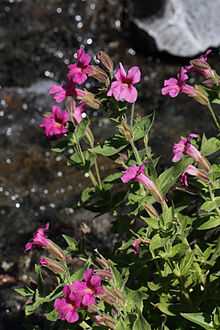Mimulus lewisii
| Mimulus lewisii | |
|---|---|
 | |
| Mimulus lewisii in Mount Rainier National Park | |
| Scientific classification | |
| Kingdom: | Plantae |
| (unranked): | Angiosperms |
| (unranked): | Eudicots |
| (unranked): | Asterids |
| Order: | Lamiales |
| Family: | Phrymaceae |
| Genus: | Mimulus |
| Species: | M. lewisii |
| Binomial name | |
| Mimulus lewisii Pursh | |
Mimulus lewisii (Lewis' monkeyflower, great purple monkeyflower) is a perennial plant in the family Phrymaceae. It is named in honor of explorer Meriwether Lewis. Together with other species in Mimulus section Erythranthe, it serves as a model system for studying pollinator-based reproductive isolation.
Description
Mimulus lewisii is a perennial herb, with stem length ranging from 25-80 cm and individual leaves ranging from 20-70 mm. The vegetative tissue is covered with fine hairs. The flowers are medium in size, set on fairly long (30-70 mm) pedicels, and range in color from pale pink (generally found in the Sierra Nevada populations) to dark magenta (more common in the Cascade Range and Rocky Mountains populations), with a central pair of carotenoid-rich yellow nectar guides covered in trichomes on the lower lobe of the corolla. Occasional populations of white-flowered individuals (which do not express anthocyanin pigments in the corolla) are known.[1][2][3]
Distribution
Mimulus lewisii is native to western North America from Alaska to California to Colorado, where it grows in moist habitat such as streambanks, and is generally found at higher elevations in montane areas. It overlaps with its sister species, Mimulus cardinalis, in the Sierra Nevada mountains in California.
Pollination
Mimulus lewisii is pollinated by bees (primarily Bombus and Osmia), which feed off of its nectar and transfer its pollen. Although it is fully interfertile with its sister species, Mimulus cardinalis, the two do not interbreed in the wild, a difference ascribed primarily to pollinator differences (M. cardinalis is pollinated by hummingbirds) in areas of overlap.[4] Traits affecting pollinator preference between these two species are currently under study, with evidence strongly linking this preference to color differences between the species.[5]
See also
References
External links
![]() Media related to Mimulus lewisii at Wikimedia Commons
Media related to Mimulus lewisii at Wikimedia Commons